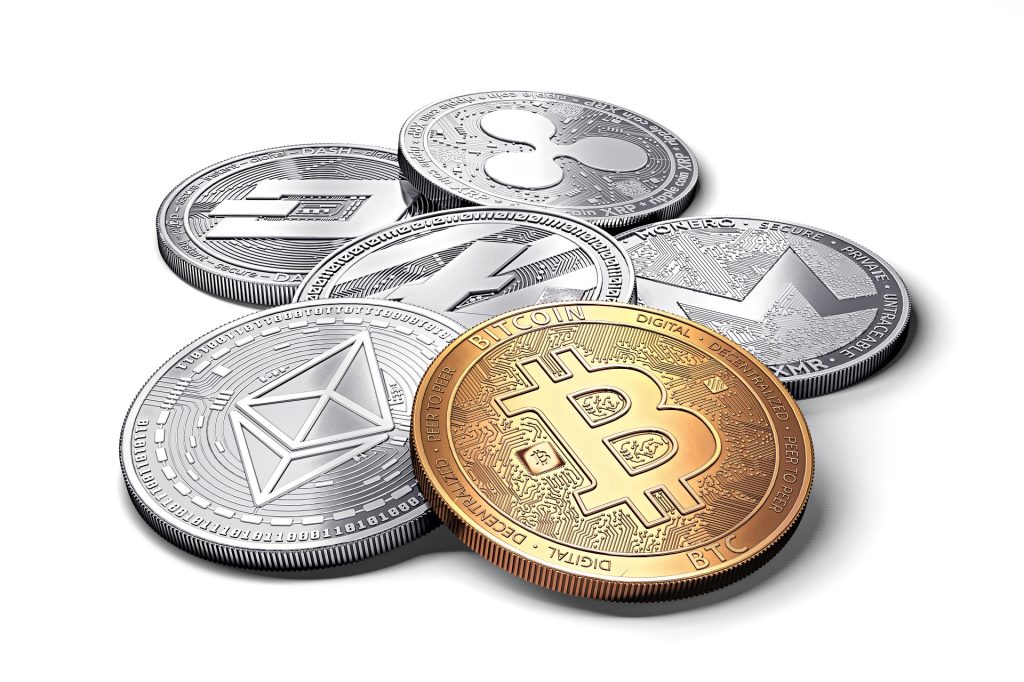A cryptocurrency is a digital or virtual currency that is secured using cryptography and thus virtually impossible to counterfeit or duplicate. Many cryptocurrencies are decentralized networks based on blockchain technology—a distributed ledger maintained by a network of computers spread across the globe.
Cryptocurrencies, by definition, are not produced or controlled by any centralized authority, making them theoretically immune to government interference or manipulation.
Cryptocurrencies are digital or virtual currencies based on cryptographic algorithms. They allow people to make secure online payments without the use of third-party intermediaries. The term “crypto” refers to the various encryption algorithms and cryptographic techniques that protect these records, such as elliptical curve encryption, public-private key pairs, and hashing functions.
Cryptocurrencies might be mined or purchased on cryptocurrency exchanges. Some e-commerce sites do not accept cryptocurrencies as payment methods. Cryptocurrency values, in particular Bitcoin’s, have seen a tremendous boost in recent months, making them popular as trading instruments. To a lesser extent, they are utilized for cross-border transfers.
Blockchain technology is at the heart of Bitcoin’s popularity and usefulness. Blockchain, as the name suggests, is a set of linked blocks or an online ledger. Each block includes a list of transactions that have been independently verified by all members of the network.
In order to confirm a new block, every node must verify it first. This makes forging transaction histories nearly impossible.
The data within the online ledger must be confirmed by the entire network of an individual node, or computer storing a copy of the ledger.
Blockchain technology, according to experts, may be used in a variety of industries and procedures, including online voting and crowdfunding. JPMorgan Chase & Co., for example, is experimenting with blockchain technology to cut costs by simplifying payment processing.
Bitcoin is the most popular and valuable cryptocurrency in the world. Satoshi Nakamoto, an unknown individual, invented it and released it to the public in a white paper in 2008. There are now thousands of cryptocurrencies available on the market.
Each cryptocurrency has a unique function and set of specifications. For instance, Ethereum’s ether is meant to be used as gas for its smart contract platform. Similarly, Ripple’s XRP is utilized by banks to make cross-border transfers easier.
Bitcoin, which was released to the public in 2009, is by far the most widely traded and documented cryptocurrency. In May 2022, there were over 19 million bitcoins in circulation with a market capitalization of around $576 billion. Only 21 million bitcoins will ever exist.
In the aftermath of Bitcoin’s popularity, numerous “altcoins” have been developed. Some are clones or forks of Bitcoin, while others are new currencies that were constructed from the ground up. Solana, Litecoin, Ethereum, Cardano, and EOS are among them. By November 2021, the overall value of all cryptocurrencies in circulation had risen to over $2 trillion—nearly 41% of it was represented by Bitcoin.
Currencies not affiliated with any commodity, like dollars, get their value from the government or other financial institutions. For example, if you have a one dollar bill, it is backed by the Federal Reserve.
Cryptocurrencies are not backed by any public or private entities, so their legal status is unclear in different financial jurisdictions. Cryptocurrencies have mostly functioned outside existing financial infrastructure, making it difficult to use them in daily transactions and trading. In June 2019, the Financial Action Task Force (FATF) recommended that wire transfers of cryptocurrencies should be subject to requirements for compliance with anti-money laundering regulations.
El Salvador is the first and only country in the world as of December 2021 to allow Bitcoin as legal tender for monetary transactions. The regulation of cryptocurrency differs depending on location.
Bitcoin is legally considered property in Japan due to the Payment Services Act.
China, as previously reported by CBNC and other sources, has banned cryptocurrency exchanges and mining. Within its borders, China has prohibited cryptocurrency exchanges and mining. In December, it was said that India is working on a framework for cryptocurrencies.
Derivatives and other products that use cryptocurrencies will need to qualify as “financial instruments” in order for them to be legal in the European Union. In June 2021, rules were set by The Markets in Crypto-Assets (MiCA) regulation for companies or vendors providing financial services using cryptocurrencies was released by the European Commission.
The United States has the biggest and most sophisticated financial market in the world, where crypto derivatives like Bitcoin futures are available on exchanges such as the Chicago Mercantile Exchange. However, this does not mean that everyone is allowed to invest in Bitcoin or Ethereum. The Securities and Exchange Commission (SEC) has said that these two cryptocurrencies are not securities.
Cryptocurrencies have earned a poor reputation as an unstable investment, owing to high investor losses caused by frauds, hacks, and bugs. Although the underlying cryptography is generally safe, using and keeping crypto assets may be complicated for new users.
In addition to market risks associated with speculative assets, cryptocurrency investors should be aware of the following dangers:
There is no way to reverse or cancel a cryptocurrency transaction once it has been sent, unlike with traditional finance. According to some calculations, around a fifth of all bitcoins are now locked due to forgotten passwords or incorrect sending addresses.
Regulatory concerns: Many governments are still attempting to regulate cryptocurrencies as securities, currencies, or both, despite the fact that they have been designated as such. It might be tough to sell cryptocurrencies suddenly if a government bans them.
Counterparty risks: Many investors and merchants use exchanges or other custodians to store their cryptocurrency. The loss of one’s entire investment if a third party fails would be due to theft or loss by one of these third parties.
There are few protections against fraudulent or unethical management practices because there aren’t many uniform laws. Many investors have lost significant sums to management teams that failed to deliver a product.
Risks associated with programming: Some investment and lending platforms utilize automated smart contracts to manage user deposits. By investing in one of theseplatforms, you assume the risk that an error or security flaw in the programming could lead to losing your deposit.
Market Manipulation: Market manipulation is still a big issue in the cryptocurrency world, and several exchanges have been accused of artificially propping up or downing the price of their assets.
Despite the dangers, cryptocurrencies have experienced a significant increase in value, with the total market capitalization surpassing $1 trillion.
While there is no guarantee of success, some investors have made a lot of money by taking the risk and investing in early-stage cryptocurrencies.
Cryptocurrencies were created with the aim of revolutionizing banking infrastructure. There are, however, drawbacks to every upheaval. There are several contrasts between the theoretical ideal of a decentralized system using cryptocurrencies and its actual implementation at this time in cryptocurrency development.
The following are some advantages and disadvantages of cryptocurrencies.
Advantages
Cryptocurrencies are a new, decentralized paradigm for money. In this mechanism, intermediaries like banks and monetary institutions are not required to establish trust and enforce transactions between two parties. As a result, a system based on cryptocurrencies eliminates the risk of having a single point of failure, such as a big bank, causing a chain reaction of crises around the world similar to what occurred in 2008 when institutions in the United States failed.
Cryptocurrencies allow you to send money directly from one party to another without the need for a third party, such as a bank or a credit card company. Public and private keys are used in these decentralized transactions, as well as various incentive systems, such as proof of work and proof of stake.
Cryptocurrency transfers don’t use third-party intermediaries, making them quicker than standard money transfers. In decentralized finance, flash loans are an example of such a transfer. Without needing collateral, these transactions can be completed in just seconds and are often used for trading purposes. Investing in cryptocurrency can be profitable. Cryptocurrencies have exploded in value in the previous decade, eclipsing $2 trillion at one point. Bitcoin was worth more than $550 billion as of May 2022 in crypto markets.
The cryptocurrency world is being put to the test by the recent remittance boom. Cryptocurrencies, such as Bitcoin act as an intermediary currency to help those transferring money across borders. The process usually works like this: change a fiat currency into Bitcoin (or another cryptocurrency), make the border crossing, and finally convert it back into a fiat currency at your destination. This makes transfers quicker and often cheaper.
Disadvantages
Cryptocurrencies are pseudonymous rather than truly anonymous, as they leave a digital footprint that can be tracked by law enforcement. They provide the potential for government or federal authorities to follow the financial activities of ordinary individuals.
Cryptocurrencies have become a useful tool for unlawful activities like money laundering and black market purchases. The case of Dread Pirate Roberts, who ran an online marketplace to sell drugs on the dark web, is already well-known. Hackers have also taken to using cryptocurrencies for ransomware attacks.
Cryptocurrencies are supposed to be owned and distributed by many across a blockchain. In actuality, however, only a tiny number of holders possess the majority of these assets. For instance, research from MIT showed that in 2020 just 11000 investors held 45% of Bitcoin’s value.
Cryptocurrencies boast that anyone can mine them with only a computer and an Internet connection. Nevertheless, mining for popular cryptocurrencies necessitates a lot of energy – sometimes costing as much power to run as entire countries use. The uncertainly of mining returns along with the expensive energy costs have caused miners to gravitate towards large firms who regularly rake in billions of dollars in revenue. According to an MIT study, just 10% of miners are responsible for 90% of total cryptocurrency mined worldwide.
Although blockchains for cryptocurrencies are quite secure, other crypto storage locations, such as exchanges and wallets, can be hacked. Cryptocurrency exchanges and wallets have been hacked on numerous occasions, resulting in the loss of hundreds of millions of dollars’ worth of “money.”
The main issue with cryptocurrencies is their instability in public markets. For example, the value of Bitcoin surged to $17,738 in December 2017 but then plummeted to only $7,575 a few months later.
Cryptocurrencies are thus seen by some economists as a passing fad or speculative bubble.
Cryptocurrencies are digital assets that rely on cryptography for security. They’re a relatively new technology, so they tend to be quite speculative. Make sure you understand the risks before investing any money.


